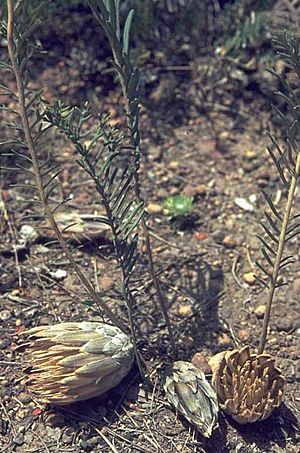Banksia bipinnatifida facts for kids
Quick facts for kids Banksia bipinnatifida |
|
|---|---|
 |
|
| At Red Hill | |
| Scientific classification | |
| Genus: |
Banksia
|
| Species: |
bipinnatifida
|
| Subspecies | |
|
|
| Synonyms | |
|
|
Banksia bipinnatifida is a special type of shrub found only in Western Australia. It's a low-growing plant that spreads out along the ground. This plant has a hidden underground stem called a lignotuber. It grows just a few leaves that are deeply divided. Its flowers are large and can be cream or pale yellow. After flowering, it grows big fruits.
Contents
What Does Banksia bipinnatifida Look Like?
Banksia bipinnatifida is a shrub that grows low to the ground. It has an underground stem called a lignotuber. This helps the plant survive fires. It only has a few leaves that grow above the ground.
Leaves and Flowers
The leaves of this plant are very unique. They are "bipinnatipartite." This means they are deeply cut into many smaller parts. These smaller parts are also cut, making the leaf look like a fern. Each leaf can be from 7 to 33 centimeters long. They are also 3 to 7 centimeters wide. The small parts of the leaves are long and thin. Their edges are rolled under and have tiny hairs.
The flowers grow in spikes at the end of the underground stem. Each spike has 30 to 45 flowers. Each flower is surrounded by special leaves called bracts. These bracts are 4.5 to 8 centimeters long. The flower itself, called the perianth, is pink and cream or pale yellow. It is 4 to 5.7 centimeters long. The part of the flower that receives pollen, the pistil, is 4.3 to 6 centimeters long.
When It Blooms and Fruits
This plant usually blooms from October to November. After the flowers, it grows a fruit. This fruit is shaped like an egg. It is called a follicle. Each follicle is about 1.7 to 2.3 centimeters long. It is also 1.3 to 1.7 centimeters wide.
How Was Banksia bipinnatifida Named?
The first samples of this plant were collected in 1827. Charles Fraser found them near the Swan River. This was during an exploration trip led by Captain Stirling.
Formal Description
In 1830, a botanist named Robert Brown officially described the plant. He gave it the name Dryandra bipinnatifida. He published this description in a special book about plants. The name "bipinnatifida" comes from Latin. It describes how the leaves look like they are cut twice.
Changing Names
For a long time, this plant was part of the Dryandra group. But in 2007, two scientists, Austin Mast and Kevin Thiele, studied these plants again. They decided that all Dryandra plants should be moved into the Banksia group. So, Dryandra bipinnatifida became Banksia bipinnatifida.
Different Types of Banksia bipinnatifida
In 1996, another botanist, Alex George, found two slightly different types of this plant. These are called subspecies. They were also moved to the Banksia group.
- Banksia bipinnatifida subsp. bipinnatifida: This type has a perianth (flower) that is 4.8 to 5.7 centimeters long. Its leaf parts are more than 1 millimeter wide.
- Banksia bipinnatifida subsp. multifida: This type has a shorter perianth, about 4.2 to 4.5 centimeters long. Its leaf parts are less than 1 millimeter wide.
Where Does Banksia bipinnatifida Grow?
Banksia bipinnatifida is found in Western Australia. It grows from a place called Eneabba in the north. It stretches south to Manjimup and Busselton.
Different Habitats
The subspecies bipinnatifida grows in forests and woodlands. These areas have many jarrah trees (Eucalyptus marginata). You can find it east of Perth down to Manjimup.
The subspecies multifida grows in a type of shrubland called kwongan. This is found in the northern part of where the species lives. Kwongan is a special kind of plant community in Australia.

